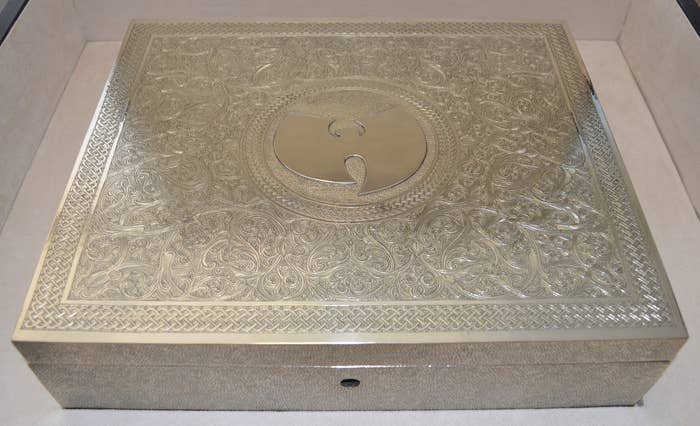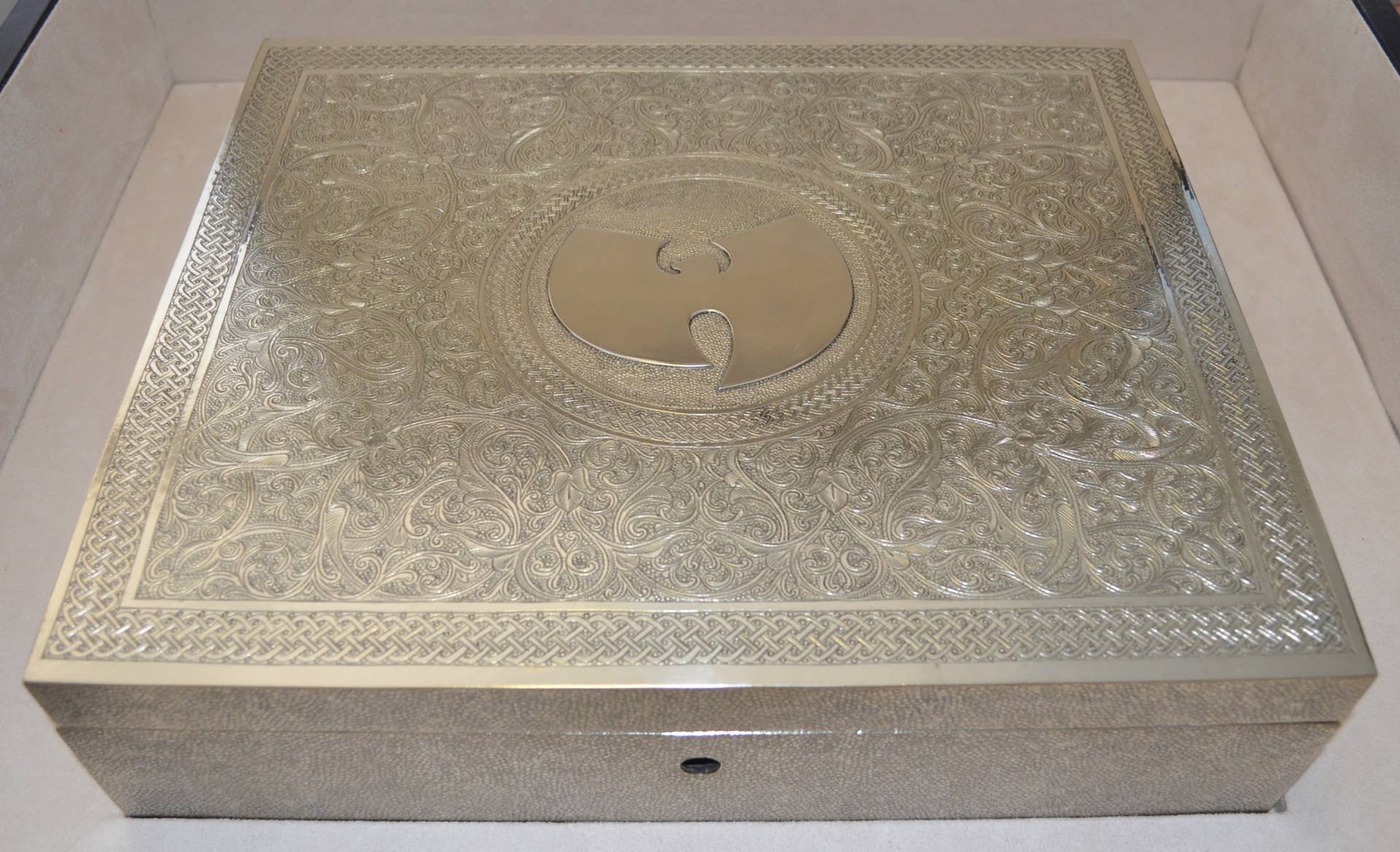
On Tuesday, July 27, 2021, the U.S. Department of Justice announced they had sold the only existing copy of Once Upon a Time in Shaolin, the mysterious album by the Wu-Tang Clan. The sale was finalized as part of a $7.3 million forfeiture judgment against Martin Shkreli, who bought the one-of-a-kind album at auction for $2 million in 2015.
We still don’t know who the current, anonymous owner is, although the lawyer who finalized the sale says the buyer will reveal him or herself in the next 30 to 60 days. Maybe then, we’ll finally get to hear one of the most rare (and anticipated) hip-hop albums of all time. Or maybe not. There’s no guarantee when it comes to this project.
Here is everything you need to know about the Wu-Tang Clan’s Once Upon A Time in Shaolin, including its epic journey to completion, its rocky history beginning with its first sale, and what might be in store for it in the years ahead.
Once Upon A Time In Shaolin is the Wu-Tang Clan’s seventh group album. Released in 2015, the double album contains 31 tracks. Aside from Ol’ Dirty Bastard, who died in 2004, all members of the Wu-Tang Clan—RZA, GZA, Inspectah Deck, Method Man, Raekwon the Chef, Ghostface Killah, U-God, Masta Killa, and Capadonna—appear on the tracklist. They worked on it for six years.
That’s the problem. You can’t. There’s only one physical copy of the album in existence. It is not online, and it is not available for purchase. Instead, it exists on two compact discs—the only two discs that have ever been pressed. Additionally, all of the masters were destroyed subsequent to the album’s pressing. It makes the chances of a leak nearly impossible, given that there’s nothing to leak in the first place. The potential leaker would need to have access to this one, single copy. And the only person with access to this single copy would be the person who currently owns it.
If only it were that easy. Since 2015, two different individuals/entities have purchased and owned the album. They each paid upwards of $2 million for that privilege. And upon purchasing the album, they are bound by a number of legal clauses. Namely, the music cannot be duplicated, and the owner cannot commercially profit off the album for many years.
The legal restrictions stipulate that the owner cannot commercially release the album until 2103. That’s 88 years from the time the project was finalized in 2015. RZA attributes the length of time to its symbolic meaning; the Wu-Tang Clan started with eight members, the digits in the year 2015 add up to eight, and an eight laid on its side is an infinity symbol.
For us to hear it sooner, the current owner’s only recourse (after buying the album for over $2 million) would be to release and distribute the album for free. The album’s first owner declined the opportunity to do so. As of July 29, 2021, the album’s second, current owner has given no indication he or she would do so either.
Not necessarily. Whoever owns the album isn’t bound to do anything with it, whether by selling the music, or giving it away, or taking it on a world tour. If the owner wanted, they could break it with a hammer or fire it into the sun. They could hoard it and just play it at dinner parties for themselves and their rich friends. They could put it in their will, pass it down to their kids, or leave it rotting in a safe deposit box. They are under no obligation to make sure this album sees the light of day.
Like many intriguing ideas, this sounded a lot more evocative on paper than it might play out in practice. RZA and co-producer Cilvaringz first conceived of this album during a trip to Egypt in 2004. Ancient Egyptian culture fixated on the idea of permanence, and the two men had the idea to create something that would last through the ages. “We’re making a single-sale collector’s item. This is like somebody having the scepter of an Egyptian king,” said RZA in an interview with Forbes.
In the same interview, RZA criticized the way music has been systematically devalued. “The idea that music is art has been something we advocated for years,” he said. “And yet it doesn’t receive the same treatment as art in the sense of the value of what it is, especially nowadays when it’s been devalued and diminished to almost the point that it has to be given away for free.”
The album’s exclusivity, RZA claims, demands that we hold it in the same regard as fine art. To offer a parallel: to see the Mona Lisa, you have to travel to Paris. It’s inherently understood that looking at a copy of it is not the same thing.
But the same mentality has not held true for music. Music gets copied and transferred billions of times, and often by people who torrent it and don’t pay the artists anything. Wu is attempting to create a sense of exclusivity and specialness, where the buyer serves as a sort of patron of the arts, like in the days of the Renaissance.
That happens to a lot of art. The Mona Lisa is on display. But the Louvre (and all art museums for that matter) have numerous pieces that are in storage and never put on display. And that’s the best-case scenario. There are many priceless paintings, owned by private collectors, which the public hasn’t seen in-person for decades. To the uber rich, art is not to be seen; it is an investment that appreciates in value, in a climate controlled vault, where no one can enjoy it.
You think? RZA’s idea of music as an exclusive commodity is a tantalizing one. But it comes with its own set of problems. The album has value. But that value may also prevent it from being seen—or in this case, heard—by anyone who might appreciate it beyond its monetary, transactional value.
He’s one of the many Wu-Tang affiliates. He formed a partnership and friendship with RZA following a show in Amsterdam in 1997, where he performed a freestyle for the Wu. He subsequently signed a record deal to Wu-Tang Records in 1999, and has opened for Wu members on subsequent tours. Cilvaringz largely composed the production in Marrakesh, Morocco, with creative input from RZA at key junctures. The goal was to replicate the raw, rugged Wu sound—the ‘93 to ‘97 sound—that made the collective famous.
After completing the production, Cilvaringz and RZA decided who would be on which track. The, they traveled to Staten Island to get the verses they needed. Cilvaringz admits that he was vague with the various members about the albums’ specifics, particularly in the project’s infancy. He had to convince each individual member that this was a worthy concept, after the fact. There are still misunderstandings and hard feelings, as Method Man demonstrated in 2015 when he told XXL, “F*ck that album.” RZA later accused XXL of misleading Method Man and giving him wrong information about the album. But that wouldn’t have happened if Method Man had fully understood the album’s concept in the first place.
So 'Once Upon A Time In Shaolin' has the classic Wu flavor? With the soul samples and kung fu movie clips?
View this video on YouTube
Indeed it does. Back in 2014, Forbes sent a camera crew and journalist to Marrakesh to meet Cilvaringz, who played them 51 seconds off the album. It sounded like vintage Wu, and Ghost sounded in rare form.
We have a tentative one. Back in 2015, Complex got an invite to the first (and last) private listening session for the album, held for a small group of art collectors, dealers, and critics. Complex received a tracklist of 26 songs, five short of the stated 31 songs. And later, auction house Paddle8, which sold the album to its first buyer, received the 31-song tracklist listed below, with the following caveat: “While the Wu-Tang Clan will retain the actual track listing and song titles of the album exclusively for the buyer, they have released a track listing of the working titles they used during the recordings, to prevent leaks. The actual song titles as they stand now, are said to be completely different and will, like the music, remain secret.”
SHAOLIN SCHOOL
ENTRANCE (INTRO) 1:57
RIVALS 4:12
STAPLE TOWN PT.1 (INTERLUDE) 0:44
ETHIOPIA 7:55
HANDKERCHIEF 0:49
STAPLE TOWN PT.2 (INTERLUDE) 1:10
THE PILLAGE OF ‘88 6:52
CENTIPEDES 7:14
THE WIDOW’S TEAR 3:55
SORROW 5:45
THE SHOGUN 4:40
BLUE [INTERLUDE] 0:55
SEMI AUTOMATIC FULL RAP FANATICS 1:56
STAPLE TOWN PT.3 (INTERLUDE) 3:30
THE RAIN 7:16
ALLAH SCHOOL
SUSTENANCE (INTRO) 0:43
LIONS 6:08
SINCE TIME IMMEMORIAL 2:32
THE SLAUGHTER MILL 6:31
THE BRUTE 3:24
IQRA 7:23
FLOWERS 5:49
POISONED EARTH 4:34
SHAOLIN 6:14
FREEDOM [INTERLUDE] 2:25
THE SWORD CHAMBER 4:05
UNIQUE 2:32
THE BLOODY PAGE 5:09
THE SAGA CONTINUOUS 6:58
SALAAM (OUTRO) 1:31
SHAOLIN SOUL [EXIT]
In addition to all surviving members of the Wu-Tang Clan, the album also includes contributions from Redman, the Wu-Tang Killa Beez (including Killarmy, Sunz of Man, and Gravediggaz), and Cher. You read that right. The “Believe” singer not only recorded for the album; she also refused to accept payment for her contributions. Mixing was done by Ken Lewis, who also worked on Kanye West’s The College Dropout and Late Registration.
British-Moroccan artist Yahya designed the casing. And ten men, working for three months, crafted the nickel-plated “box-within-a-box-within-a-box” that houses the album. Everything, from the box’s leather interior, to the carved designs on the outside, to the custom jewel case that contains the CDs themselves, was handcrafted to specification. The album also comes with a professionally leather-bound, 174-page book of liner notes printed on gilded parchment, containing lyrics, anecdotes, and background for the songs.
This is the part that’s really unfortunate. The original plan was to take it on a massive tour—to hold listening parties at art museums, perhaps even music festivals. This would culminate in the sale to an actual buyer. Unfortunately, the tour never materialized. Instead, the album was simply sold to a buyer at auction, without the public hearing any of it.
Who was the buyer, and how much did he pay?

Yeah. About that… You may remember Martin Shkreli as the “Pharma Bro.” At one time, Shkreli was arguably the most hated man in America. He gained this dubious distinction by buying the anti-parasitic drug Daraprim and raising its price by 5,000%, to $750 per pill. The medication is typically used to treat AIDS patients, pregnant women, and the elderly. Shkreli is a callous, greedy man.
Once the buyer became known to the public, RZA put out a statement, claiming he did not know about Shkreli’s price jacking before finalizing the sale. In light of that new information, the Wu-Tang Clan donated much of the album’s proceeds to charities. But still, in an interview with Bloomberg in 2016, RZA said he had no regrets about the eventual buyer, stating that Shkreli was a self-professed fan of hip-hop, and it wasn’t his place to judge who appreciates art.
Method Man reiterated in 2017 that he was confused and misled about the album’s release, and that it should have never been handled that way in the first place. Notably, Ghostface Killah called Shkreli a “shithead” for messing with drug prices.
He responded by threatening Ghost with harm, calling him an “old man” and claiming that if he heard more out of the rapper, he would remove him from the album. In a diss video, Shkreli insulted Ghostface while playing the album in the background, flanked by three hype men in masks. He demanded a handwritten apology from Ghost for his comments.
Ghostface responded to that in an 11-minute video, calling Shkreli a “fake supervillain” and referring to his hype men as “Snap, Crackle, and Pop.” The video started out funny, but it turned serious by the end, with Ghost’s mother and sister making an emotional, tearful plea for Shkreli to lower the drug prices.
Has Martin Shkreli played any cuts off the album for the public?
View this video on YouTube
Sort of. He’s played some of it in the background of interviews with the press, like during his interview with VICE and his diss video against Ghost. But he’s mainly done so for trolling purposes, rather than a genuine effort to share the music with the masses. Shkreli claimed he would leak the album if Trump won the presidency in 2016. He didn’t hold true to his word. He played a few snippets of it, but declined to release the entire thing. He has also claimed that he might break the album in half, or place it in a location so remote that people would have to make a pilgrimage to visit it.
There was a deeply amusing rumor that circulated in late 2015, that any active member of the Wu-Tang Clan or actor/comedian Bill Murray could attempt to heist the album with no legal repercussions. This turned out to be false, even though RZA also played into the joke by tweeting out, “We’re really getting the urge to call Bill Murray.” If only.
He doesn’t. He was eventually convicted on federal charges of security fraud and conspiracy to commit security fraud. In addition to a seven-year prison sentence, he was ordered by the judge to forfeit $7.3 million in assets.
Subsequent to his conviction, Shkreli attempted to sell the album on eBay, but was unsuccessful; he was sent to federal prison before completing the sale.
In 2018, a judge upheld the imprisonment and forfeiture, giving the government permission to seize the Once Upon A Time in Shaolin album by the Wu-Tang Clan. It was subsequently sold to an anonymous buyer for an undisclosed amount to cover Shkreli’s debt.
He was fairly succinct: “F*ck that n***a.”
We don’t, but here’s some good news: the lawyer who organized this second purchase said that his client will publicly reveal themselves in the 30 to 60 days. The lawyer, Peter Scoolidge, has represented RZA and Cilvaringz in the past, although he declined to comment on whether they were involved in the recent purchase. We will simply have to wait and see who this secret buyer is, and hope for the best.




